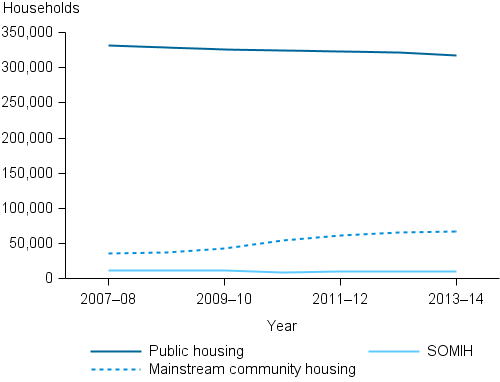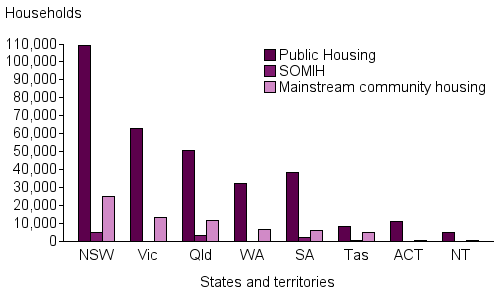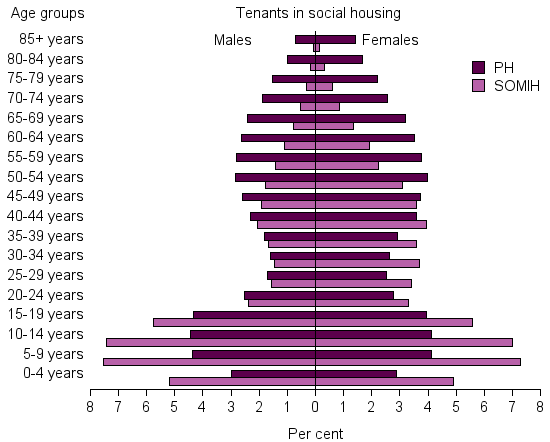Social housing tenants
Social housing is rental housing that government or non-government organisations (including not-for-profit organisations) make available to help people who are otherwise unable to access suitable affordable housing options. Social housing rents are generally set below market levels and are based on the income of the household.
Over recent years, social housing has increasingly been allocated to households with complex needs, such as those with disability and on very low incomes. As at 30 June 2014, there were 393,844 households in social housing, with the majority in public rental housing (317,000), 9,800 in state managed and owned Indigenous housing (SOMIH) and 67,000 in mainstream community housing. Although Indigenous community housing (ICH) data do not allow for number of households, as at 30 June 2014 there were 17,500 ICH dwellings.
How many tenants are in social housing?
Over time, the number of public rental housing households has decreased. Between 2007–08 and 2013–14 the number of public rental households decreased from 331,100 to 317,000 (a fall of 4%).
SOMIH households also decreased during this time, from 12,400 to 9,800.
In contrast, the number of mainstream community housing households has almost doubled between 2007–08 and 2013–14, from 35,700 to 67,000 (a rise of 88%).
These differences reflect a gradual but steady shift of focus from the public- to the community-managed sector. A decrease in the number of public rental households was offset by an increase in mainstream community housing households. This increase in distribution of housing stock reflects strategies to grow the community sector, as mainstream community housing can potentially provide more flexible and innovative affordable housing options.
Figure 1: Number of social housing households, 2007–08 to 2013–14

Source: AIHW National Housing Assistance Data Repository, 2013–14. Source data
Where is social housing located?
The geographic distribution of social housing largely follows the distribution of the general population. By jurisdiction, New South Wales had the largest number of households in social housing across public rental housing, SOMIH and mainstream community housing, followed by Victoria with the next largest numbers of public housing and community housing tenants.
Figure 2: Number of social housing households by state and territory and housing program type, 2013–14

Source: AIHW National Housing Assistance Data Repository, 2013–14. Source data
By remoteness area, Major cities had the highest proportion of households across all social housing programs, with 74% for public rental housing, 37% for SOMIH and 69% for mainstream community housing.
The proportion of public rental housing and mainstream community housing households was next highest in Inner regional areas (15% and 24%, respectively), whilst the proportion of SOMIH households was next highest in Outer regional areas (25%).
Public rental housing and community housing households both reported less than 1% in Very remote areas, whereas SOMIH households reported 8%.
Tenant demographics
Among public rental households, almost two-thirds of main tenants were female (61%). In terms of household composition, single adults made up the majority of all households (53%) followed by sole parents with dependent children (18%).
Forty-three per cent of public rental housing tenants reported a disability, although only 29% identified a disability support pension as the main source of income. However, a quarter of tenants indicated an age pension as the main source of income. As a high proportion of tenants are aged 65 years and over (32%), it is likely that some of those with a disability are on the aged pension, rather than the disability support pension.
Of SOMIH households, three quarters of main tenants were female (85%). In terms of household composition, sole parents with dependent children were the largest group (38%), followed by single adults (25%). Thirty-five per cent of SOMIH tenants reported a disability.
Of mainstream community housing households, almost three-fifths (58%) were female. Single adults represented the highest proportion of household compositions (60%), followed by group and mixed households (14%). Thirty-seven per cent of mainstream community housing tenants reported a disability.
Education
As at 30 June 2014, around half (49%) of public rental housing and almost two thirds (61%) of SOMIH main tenants indicated that their highest level of education was Year 10 or its equivalent. Less than half (43%) of community housing tenants reported attaining a Year 10 or equivalent level of education. Across all social housing programs surveyed, 2% of respondents reported that they had not completed any formal education (National Social Housing Survey 2014).
Age profile of all tenants
As at 30 June 2014, a high proportion of tenants living in public rental housing and SOMIH households were children. Almost a quarter (23%) of public rental housing and 39% of SOMIH tenants were aged 0–14 years old.
For older age groups, 31% of public rental housing and 12% of SOMIH tenants were aged 55 years and over.
The age profiles of public rental housing and SOMIH tenants differ greatly. Where almost one-third (31%) of public rental housing tenants were aged 55 years and over, over one-third (39%) of SOMIH tenants were aged 0-14 years.
Of all tenants, there were also more females than males represented for both social housing programs, with 56% for public rental housing tenants and 57% for SOMIH tenants.
Figure 3: Age and sex distribution of all tenants in public rental housing and SOMIH dwellings, 2014

Source: AIHW National Housing Assistance Data Repository, 2013–14. Source data
Employment
The 2014 National Social Housing Survey found that about 28% of public rental housing and 30% of community housing tenants were in the workforce.
The remainder of those in public rental housing and community housing households were either studying, a volunteer or full-time parent or carer, retired or unable to work due to long-term illness or disability.
In comparison, 37% of SOMIH tenants were in the workforce, although a greater proportion of SOMIH tenants were also currently unemployed (17%) than those in either public rental housing or community housing households (12% and 13%, respectively). Additionally, people in SOMIH households were less likely to be retired (16%) compared to those in public rental housing (38%) or community housing households (37%).
Tenants’ tenure
Length
Households in public rental housing and SOMIH tend to remain in tenure for long periods of time. As at 30 June 2014, 41% of public rental housing and 31% of SOMIH households had been in the same tenancy for over a decade. Most tenancies had been in place for over 5 years for public rental housing households (63%) and SOMIH households (54%). Comparable data are not available for mainstream community housing.
| Tenure length | Public Housing Number |
Public Housing Per cent |
SOMIH Number |
SOMIH Per cent |
|---|---|---|---|---|
| 6 months or less | 15,768 | 5.0 | 637 | 6.5 |
| 6 months to 1 year | 41,307 | 13.0 | 1,641 | 16.8 |
| 2 to 4 years | 59,023 | 18.6 | 2,231 | 22.8 |
| 5 to 9 years | 70,846 | 22.4 | 2,255 | 23.0 |
| 10 to 19 years | 86,318 | 27.2 | 2,128 | 21.7 |
| 20 to 29 years | 33,503 | 10.6 | 642 | 6.6 |
| 30 or more years | 10,189 | 3.2 | 255 | 2.6 |
Note 1: Mainstream community housing data not available.
Note 2: Records with missing start date have been excluded.
Source: AIHW National Housing Assistance Data Repository, 2013–14.
Nationally, 3% of public rental housing and SOMIH tenants transferred to a different dwelling in 2013–14. This may be due to state housing authorities seeking to match tenant characteristics to household size. For example, by moving a single household into a smaller dwelling to make room for a larger household composition, or tenants requesting relocation to a different geographic area, or to meet changing tenant needs. Exit rates were slightly higher, with 7% for public rental housing and 8% of SOMIH tenants ending their tenancies during 2013–14.
Satisfaction
‘Tenant satisfaction’ is defined as the proportion of tenants in social housing who said they were satisfied or very satisfied with their housing service provider. As at 30 June 2014, tenants in community housing were consistently more satisfied with their housing provider (80%) compared to other social housing providers (73% for public rental housing and 58% for SOMIH) (AIHW National Social Housing Survey 2014).
Social and economic benefits from living in social housing
Affordable, safe and secure housing can contribute to a range of health and wellbeing outcomes and contribute to people’s ability to engage economically and socially in their community. Tenants who reported social and economic participation benefits from living in social housing varied across their individual circumstances and housing programs.
Across all social housing programs, 94% of tenants reported they felt ‘more settled’ and 82% felt ‘part of the community’. In terms of employment and education, 67% of social housing tenants felt they were more able to improve their job situation and 74% felt more able to start or continue education/training. Also, 85% reported having better access to services and 94% were better able to manage their rent/money. Of all social housing tenants, 25% reported no social or economic benefit from living in social housing.


